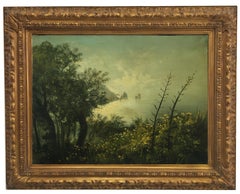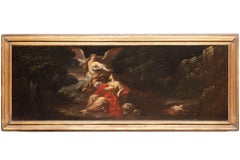Francesco D'Angiolo Art
to
1
Overall Width
to
Overall Height
to
1
1
1
1
1
1
1
1
9,980
2,753
1,376
1,373
1
Artist: Francesco D'Angiolo
VIEW OF CAPRI -Posillipo School - Italain Landscape Oil on Canvas Painting
By Francesco D'Angiolo
Located in Napoli, IT
View of Capri - Francesco D'Angiolo Italia 2004 - Oil on canvas cm. 60x80
Gold leaf gilded wooden frame available on request.
Category
Early 2000s Old Masters Francesco D'Angiolo Art
Materials
Canvas, Oil
Related Items
17th Century by Felice Torelli Hagar and the Angel Oil on Canvas
Located in Milano, Lombardia
Felice Torelli (Verona, Italy, 1667 - Bologna, Italy, 1748)
Title: Hagar and the Angel
Medium: Oil on canvas
Dimensions: without frame 41 x 116 cm - wit...
Category
Late 17th Century Old Masters Francesco D'Angiolo Art
Materials
Cotton Canvas, Canvas, Oil
$18,069 Sale Price
20% Off
H 20.67 in W 50.01 in D 1.97 in
Shepherd with Sheep, Cows and a Goat in a Landscape by Jan Frans Soolmaker
Located in Stockholm, SE
Jan Frans Soolmaker (Flanders 1635‑1685)
Shepherd with Sheep, Cows and a Goat in a Landscape
oil on relined canvas
canvas size 56 x 53 cm
frame i...
Category
17th Century Old Masters Francesco D'Angiolo Art
Materials
Canvas, Oil
$5,789 Sale Price
25% Off
H 22.05 in W 20.87 in
Figures Chatting outside Village Tavern in Mountain Landscape, Period Oil
By 19th century Dutch or Flemish school
Located in Cirencester, Gloucestershire
Dutch/ Flemish School, early 1800's
oil on canvas, framed
framed: 19 x 24 inches
canvas: 13.5 x 18.5 inches
provenance: private collection, France
condition: good and sound condition...
Category
Early 19th Century Old Masters Francesco D'Angiolo Art
Materials
Oil, Canvas
$1,233 Sale Price
30% Off
H 19 in W 24 in
Russian oil painting 'The Chase' signed C. Stoiloff
By Adolf Constantin Baumgartner-Stoiloff
Located in London, GB
Russian oil painting 'The Chase' signed C. Stoiloff
Russian, early 20th Century
Frame: Height 84cm, width 122cm, depth 7cm
Canvas: Height 66cm, wi...
Category
20th Century Old Masters Francesco D'Angiolo Art
Materials
Canvas, Oil
$11,430 Sale Price
53% Off
H 33.08 in W 48.04 in D 2.76 in
Naval Battle Engagement at Sea Large Busy Battle Scene Many Ships, Signed Oil
Located in Cirencester, Gloucestershire
English School, early 20th century
signed
oil painting on canvas, unframed
canvas: 17 x 24 inches
provenance: private collection, Eng;and
condition: good and sound condition, minor ...
Category
Early 20th Century Old Masters Francesco D'Angiolo Art
Materials
Oil, Canvas
$1,333 Sale Price
30% Off
H 17 in W 24 in
Fine 17th Century Dutch Old Master Oil Military Encampment Figures on Horseback
By Philips Wouwerman
Located in Cirencester, Gloucestershire
The Military Encampment
Dutch School, 17th century
circle of Philips Wouwermans (Dutch 1619-1668)
oil painting on canvas, in 18th century gilt frame
canvas measures: 19.5 x 17 inches...
Category
17th Century Old Masters Francesco D'Angiolo Art
Materials
Oil, Canvas
$3,762 Sale Price
30% Off
H 27 in W 24 in D 2 in
Landscape Near Felday, Surrey
By Abraham Hulk the Younger
Located in Hillsborough, NC
Dutch/English artist Abraham Hulk the Younger (1851-1922) is most known for landscapes of the British countryside. This work is one of a pair (the second work is also available by s...
Category
Late 19th Century Old Masters Francesco D'Angiolo Art
Materials
Canvas, Oil
$1,960 Sale Price
30% Off
H 27 in W 22.75 in D 2.13 in
Antique English Grand Tour Old Master Oil Figures Classical Arcadian Landscape
Located in Cirencester, Gloucestershire
Classical Landscape
English School, early 19th century, unsigned
oil on canvas, framed
framed: 29 x 37 inches
canvas : 19 x 27 inches
Provenance: private collection, UK
Condition: th...
Category
Early 19th Century Old Masters Francesco D'Angiolo Art
Materials
Oil, Canvas
$2,333 Sale Price
30% Off
H 29 in W 37 in
Huge 18th Century Italian Oil Painting Shipping in Merchant Port Many Figures
Located in Cirencester, Gloucestershire
The Merchants Port
Italian School, 18th century
oil painting on canvas, framed
framed: 37 x 58 inches
canvas: 32 x 52 inches
provenance: private collection, UK
condition: very good a...
Category
18th Century Old Masters Francesco D'Angiolo Art
Materials
Oil, Canvas
$6,191 Sale Price
30% Off
H 37 in W 58 in
Fishing at Dawn Old Trading Port with Many Figures Large Oil Painting
Located in Cirencester, Gloucestershire
Fishing at Dawn
English artist after an earlier work (see inscription verso)
signed oil painting on canvas, framed
inscribed verso
framed: 23 x 31 inches
canvas: 18 x 26inches
proven...
Category
Late 20th Century Old Masters Francesco D'Angiolo Art
Materials
Canvas, Oil
$1,714 Sale Price
30% Off
H 23 in W 31 in
HUGE 17thC ITALIAN OLD MASTER OIL PAINTING - KING & COURT FIGURES ROMAN BUILDING
Located in Cirencester, Gloucestershire
Artist/ School: Italian School, 17th century.
Title: A King and Queen before court figures, amidst a classical landscape with Roman columns.
Medium: oil painting on canvas, framed
...
Category
17th Century Old Masters Francesco D'Angiolo Art
Materials
Canvas, Oil
$8,572 Sale Price
30% Off
H 45 in W 60 in D 2 in
Large Traditional Dutch River Landscape with Old Town & Houses Signed Oil
Located in Cirencester, Gloucestershire
Landscape in Holland (titled verso)
Dutch School, 20th century
signed oil painting on canvas, framed
framed: 30 x 42 inches
canvas: 24 x 36 inches
provenance: private collection, Eng...
Category
Late 20th Century Old Masters Francesco D'Angiolo Art
Materials
Oil, Canvas
$2,286 Sale Price
30% Off
H 30 in W 42 in
Previously Available Items
VENICE
By Francesco D'Angiolo
Located in Napoli, IT
Venice - Francesco D'Angiolo Italia 2002 - Oil on canvas cm.20x55
Category
Early 2000s Old Masters Francesco D'Angiolo Art
Materials
Canvas, Oil
Francesco D'angiolo art for sale on 1stDibs.
Find a wide variety of authentic Francesco D'Angiolo art available for sale on 1stDibs. You can also browse by medium to find art by Francesco D'Angiolo in canvas, fabric, oil paint and more. Much of the original work by this artist or collective was created during the 21st century and contemporary and is mostly associated with the Old Masters style. Not every interior allows for large Francesco D'Angiolo art, so small editions measuring 32 inches across are available. Customers who are interested in this artist might also find the work of Giulio Di Sotto, Salvatore Marinelli, and Antonio Savisio. Francesco D'Angiolo art prices can differ depending upon medium, time period and other attributes. On 1stDibs, the price for these items starts at $3,678 and tops out at $3,678, while the average work can sell for $3,678.



